Key takeaways
- French street art reflects local culture and social issues, with each piece telling a unique story.
- Photographing street art captures fleeting moments, preserving cultural expressions that might disappear over time.
- Locations like Belleville and Canal Saint-Martin are vibrant hubs for street art, rich with narratives and artistic diversity.
- Key tips for aspiring photographers include patience, engaging with locals, and utilizing natural light for the best shots.
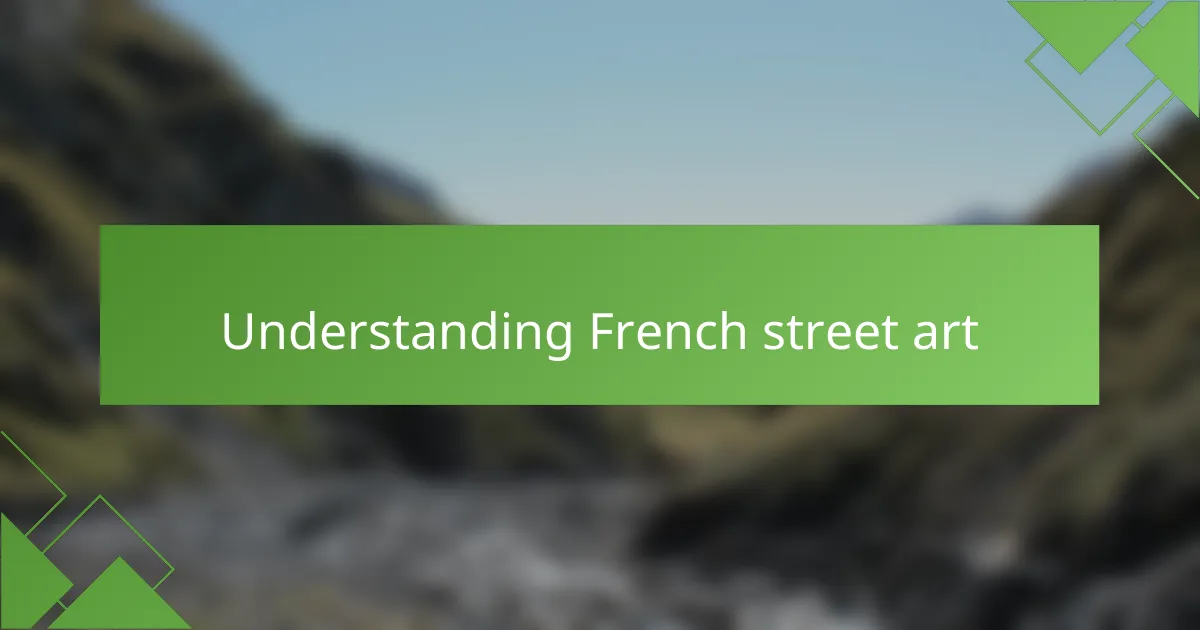
Understanding French street art
French street art is a vibrant and dynamic reflection of Parisian culture. While exploring the streets, I often found myself captivated by the stories each piece told. Whether it was a whimsical mural or a thought-provoking stencil, I realized that these artworks offer a glimpse into the social issues and emotions of the moment.
In my experience, every corner of Paris reveals the spirit of its community through street art. I remember stumbling upon a mural expressing solidarity during a local protest. This connection made me appreciate not just the aesthetic but the powerful messages behind these creations. Each artwork, whether grand or subtle, contributes to the city’s heartbeat.
- Street art as a voice: Many pieces comment on social issues, politics, and cultural dialogues.
- Diversity of styles: From graffiti to intricate murals, Paris showcases a range of artistic expressions.
- Location matters: Areas like Belleville and the Marais are rich in street art, reflecting different neighborhood vibes.
- Artist anonymity: Many street artists prefer to remain unknown, challenging the notion of fame and artistic ownership.
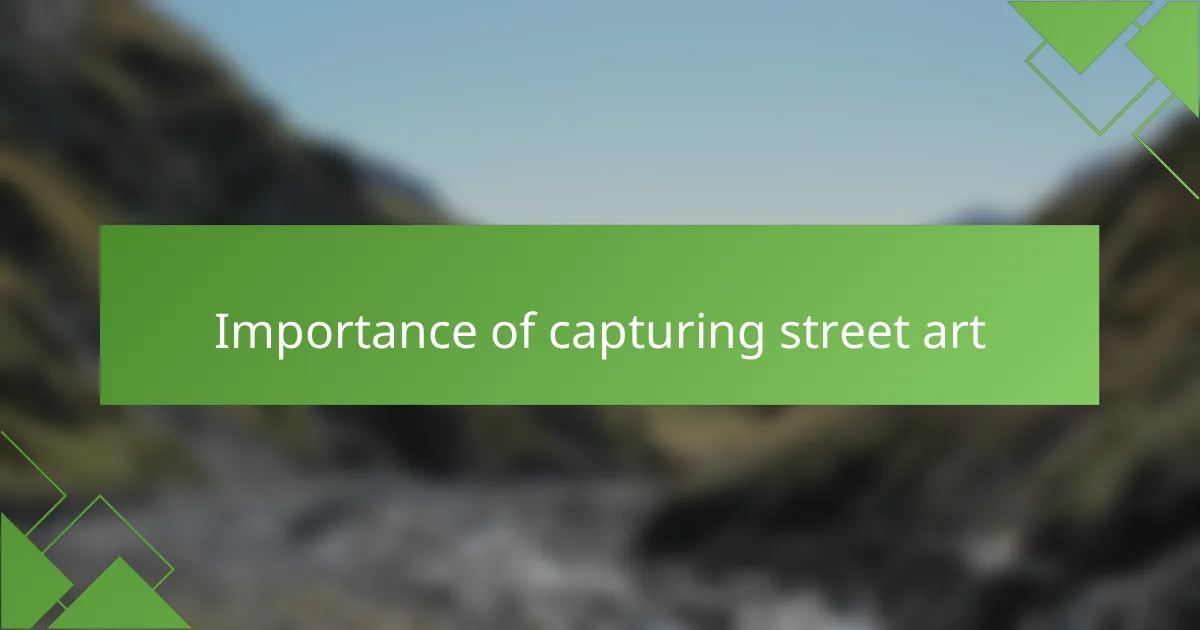
Importance of capturing street art
Capturing street art is not just about taking pictures; it’s about preserving a slice of culture. Each piece tells a story, reflecting the social, political, and emotional currents of the community. I remember when I stumbled upon a vibrant mural in a hidden alley of Paris; it felt like I had discovered a secret conversation between artists and their audience.
The importance of these images lies in their ability to document transient expressions that might vanish with time. Street art often changes rapidly, making the moments you capture invaluable. For me, each photograph acts as a time capsule, reminiscent of the feelings and experiences that surrounded the artwork.
Here’s a little comparison of the impact of traditional art versus street art:
| Aspect | Traditional Art | Street Art |
|---|---|---|
| Accessibility | Often confined to galleries | Available to everyone in public spaces |
| Cultural Reflection | Often represents established artists | Represents the voice of the community |
| Ephemerality | Long-lasting and preserved | Often temporary and fleeting |
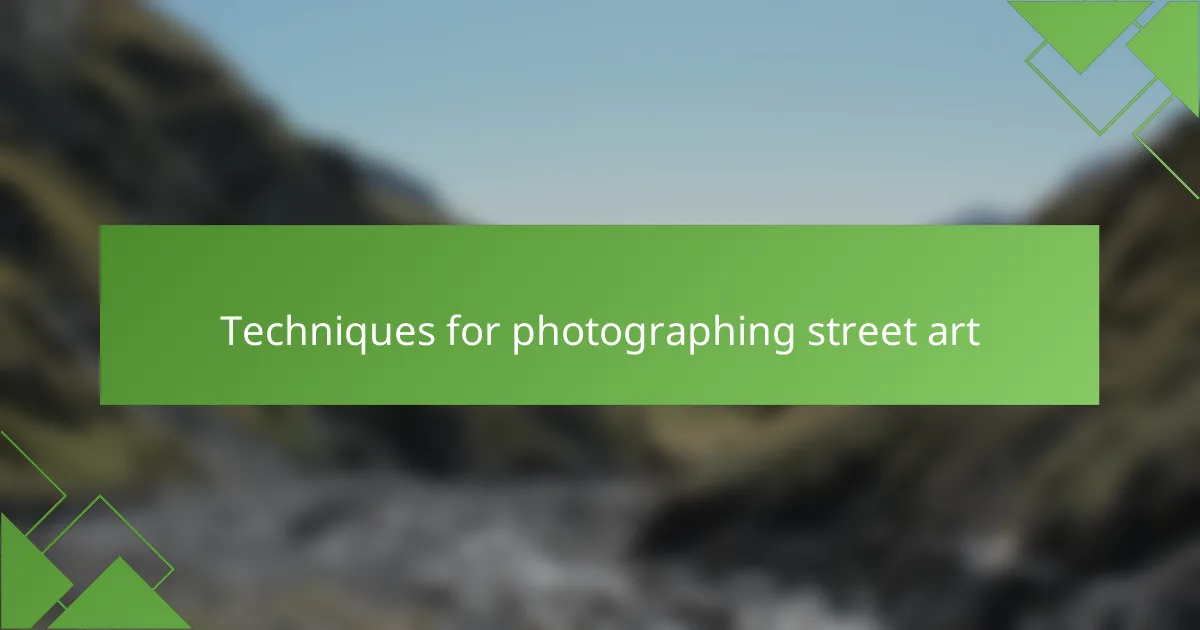
Techniques for photographing street art
To effectively photograph street art, I’ve found that using natural light is crucial. The soft glow of early morning or late afternoon can enhance colors and textures, bringing the artwork to life. Have you ever stood in front of a mural during golden hour? It’s a spectacular experience as the light shifts, revealing elements you might otherwise miss.
In my practice, framing the shot is just as vital. I often try to include surrounding elements, like the textures of the walls or people interacting with the art. This not only contextualizes the piece but also conveys the atmosphere of the neighborhood. One of my favorite photos features a colorful mural set against a weathered brick wall, which tells a compelling story of contrast and resilience.
Don’t overlook the importance of angles. I love experimenting with different perspectives, whether that means crouching low to capture a towering piece or shooting from above. Each angle can evoke distinct emotions or highlight aspects that resonate in unexpected ways. It’s fascinating how a simple shift can transform a photo from ordinary to captivating.
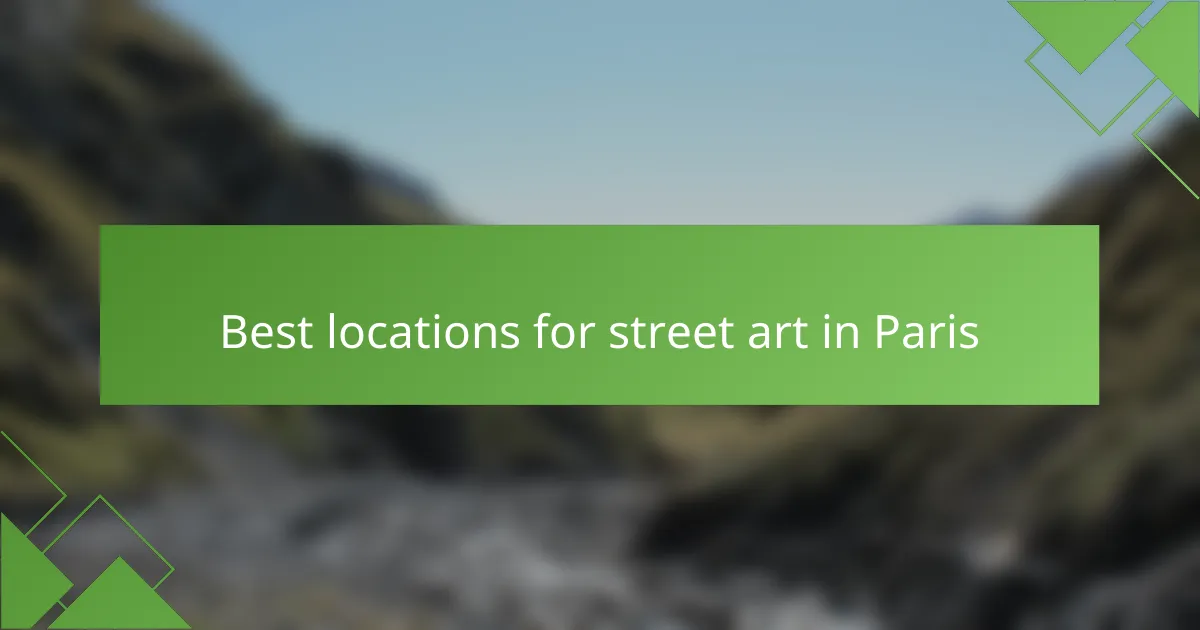
Best locations for street art in Paris
When it comes to capturing the vibrant essence of Parisian street art, location is everything. I still remember my first visit to the Canal Saint-Martin area; the artwork seemed to pulse with the energy of the city itself. Each mural told a story, and as I stood there with my camera, I felt an undeniable connection to the artistic spirit that flows through these streets.
Some of my favorite spots to explore include:
- Belleville: This neighborhood is a canvas bursting with color, showcasing the works of both local and international artists.
- Rue Dénoyez: A narrow street that feels like an open-air gallery, where every corner offers a new surprise.
- Montmartre: Beyond the famous Sacré-Cœur, the surrounding streets harbor whimsical pieces that invite you to get lost in their charm.
- Le Marais: Known for its trendy vibe, Le Marais also features stunning street art that reflects the area’s artistic history.
- Canal Saint-Martin: Beyond its picturesque setting, the canal’s banks are adorned with striking murals that capture the eclectic Parisian spirit.
Exploring these locations has not only helped me grow as a photographer but also deepened my appreciation for the stories that street art tells—a true visual dialogue between the artist and the viewer.
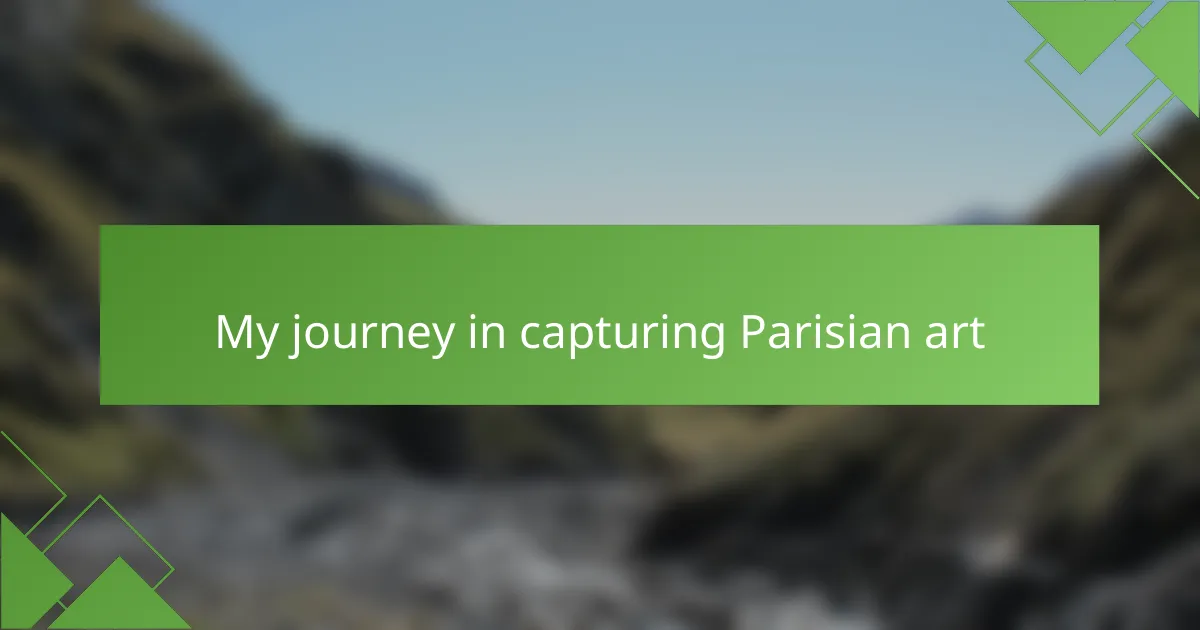
My journey in capturing Parisian art
Exploring the vibrant streets of Paris has always filled me with excitement, particularly when it comes to capturing the myriad expressions of street art. On one of my first outings, I stumbled upon an incredible mural in Le Marais that seemed to pulse with the city’s energy. The colors were so vivid that it felt as if the wall itself was talking to me, urging me to document its story.
Over time, I started to develop a keen eye for spotting hidden gems; some of my favorites blended seamlessly into their surroundings, almost like secret messages waiting to be discovered. I found joy in connecting with locals who shared their own insights, adding layers to my understanding of the art’s context.
- I learned to be patient and observant, waiting for the perfect moment when the light interacted beautifully with the artwork.
- Each piece I captured told its own story, reflecting the character of the neighborhood where it resided.
- Some artworks had an ephemeral vibe, reminding me of the transient nature of art and life itself.
- I often felt a rush of inspiration when I discovered a new artist, fueling my passion for documenting their voice in the urban dialogue.
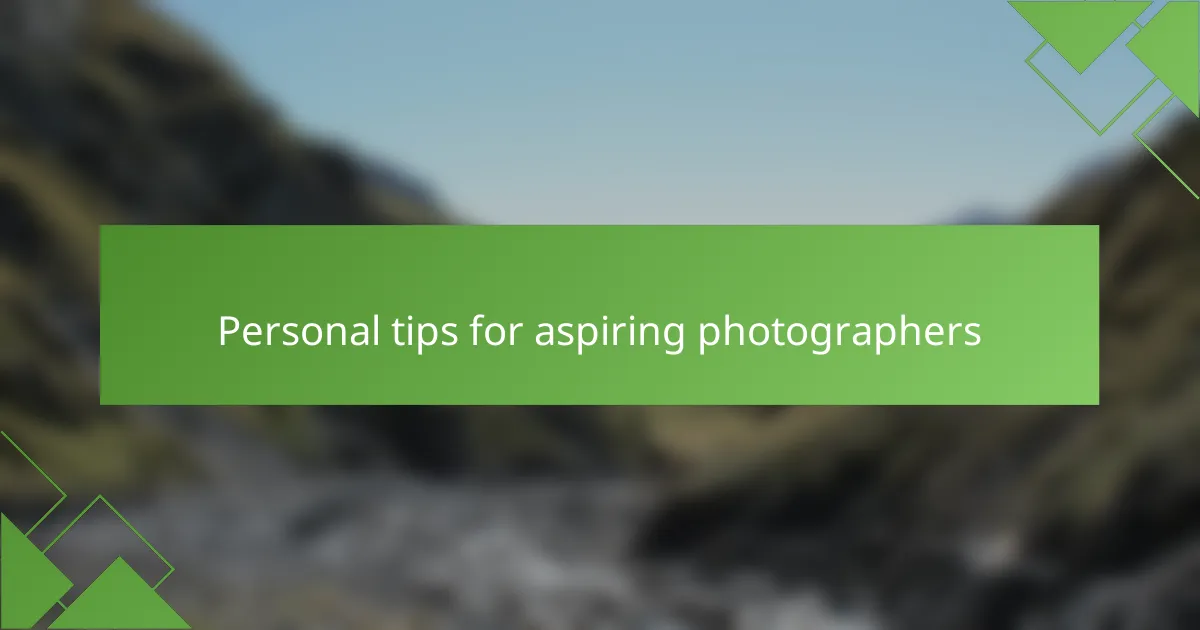
Personal tips for aspiring photographers
When I first set out to capture the essence of Parisian street art, I realized that patience is key. I remember wandering through the vibrant neighborhoods, sometimes for hours, waiting for the perfect moment. It’s easy to get distracted by the bustling crowds, but I found that taking a step back and observing my surroundings often led to the most authentic shots.
While you’re out there with your camera, consider these tips to enhance your street photography experience:
- Blend in: Dress casually to avoid drawing attention to yourself.
- Timing is everything: Early mornings or late evenings offer the best light and fewer people.
- Stay curious: Explore unknown streets, as the best art often hides in less-traveled areas.
- Engage with locals: They can provide insight into the work and its significance.
- Be respectful: Always ask for permission if you plan to photograph artists at work to foster goodwill.
Every time I pressed the shutter, it felt like I was capturing not just art, but a moment in the city’s heartbeat.